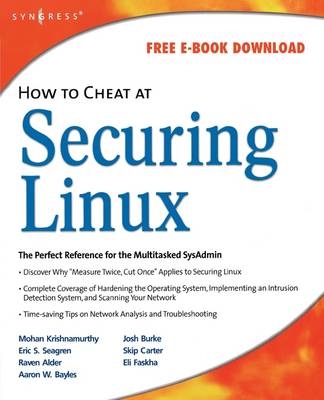
How to Cheat at Securing Linux
Syngress Media,U.S. (Verlag)
978-1-59749-207-2 (ISBN)
- Keine Verlagsinformationen verfügbar
- Artikel merken
Linux servers now account for 33% of all networks servers running worldwide (Source: IDC). The top 3 market share holders in the network server space (IBM, Hewlett-Packard, and Dell) all use Linux as their standard operating system.
This book teaches Linux system administrators how to protect their servers from malicious threats.
As with any technologies, increased usage results in increased attention from malicious hackers. For years a myth existed that Windows was inherently less secure than Linux, because there were significantly more attacks against Windows machines than Linux. This was a fallacy. There were more attacks against Windows machines because there were simply so many more Windows machines to attack. Now, the numbers tell the exact opposite story. Linux servers account for 1/3 of all servers worldwide, but in 2005 there were 3 times as many high-severity security vulnerabilities discovered on Linux servers (Source: IDC).
This book covers Open Source security, implementing an intrusion detection system, unearthing Rootkits, defending against malware, creating Virtual Private Networks, and much more.
Dr. James Stanger is a web technologist, security consultant, and open source advocate. He is currently President and Chief Certification Architect at Certification Partners, LLC, where he develops the Certified Internet Web Professional and the CTP+ certification programs. He is active in the open source movement as well as with the Linux Professional Institute. He is a contributing author of the LPI Linux Certification in a Nutshell, 2nd Edition, author of How to Cheat at Securing Linux. He has Stanger has created certifications and courses of instruction for companies and organizations such as CIW, IBM, Symantec, and CompTIA. He currently is President and Chief Certification Architect of Certification Partners, LLC, and Chair of the Linux Professional Institute Advisory Council. He also sits on several boards and councils, including the CompTIA Network+ and Server+ advisory committees, as well as for Kaplan University, American Public University System, Mesa Community College, and Snow College. He is also a social networking and Web 2.0 consultant. A respected speaker, he has been invited to present at various forums in the United Kingdom, China, and North America. Dr. Stanger was an educator and consultant, holding teaching positions at the University of California at Riverside, the University of Redlands, and Crafton Hills College. Dr. Stanger earned a B.A. and a Masters degree from Brigham Young University and a Ph.D. from the University of California at Riverside. He is a CIW Master Administrator, and also holds the Linux+, Security+, A+, and Convergence Technologies Professional (CTP) certifications.
Chapter 1: Introduction to Open Source Security
Chapter 2: Hardening the Operating System
Chapter 3: System Scanning and Probing
Chapter 4: Implementing an Intrusion Detection System
Chapter 5: Troubleshooting the Network with Sniffers
Chapter 6: Unearthing Rootkits
Chapter 7: Defending Against Malware
Chapter 8: Defending Databases
Chapter 9: Network Authentication and Encryption
Chapter 10: Avoiding Sniffing Attacks through Encryption
Chapter 11: Creating Virtual Private Networks
Chapter 12: Implementing and Maintaining a Firewall
| Erscheint lt. Verlag | 5.12.2007 |
|---|---|
| Verlagsort | Rockland, MA |
| Sprache | englisch |
| Maße | 191 x 235 mm |
| Gewicht | 730 g |
| Themenwelt | Informatik ► Betriebssysteme / Server ► Unix / Linux |
| Informatik ► Netzwerke ► Sicherheit / Firewall | |
| Mathematik / Informatik ► Informatik ► Web / Internet | |
| ISBN-10 | 1-59749-207-8 / 1597492078 |
| ISBN-13 | 978-1-59749-207-2 / 9781597492072 |
| Zustand | Neuware |
| Informationen gemäß Produktsicherheitsverordnung (GPSR) | |
| Haben Sie eine Frage zum Produkt? |
aus dem Bereich


